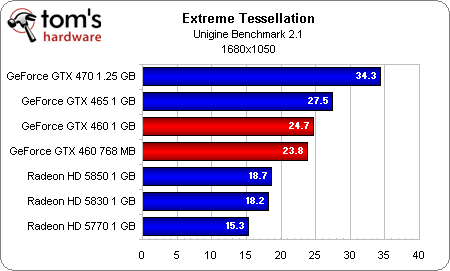Nvidia GeForce GTX 460: The Fermi We Were Waiting For
In Theory: Tessellation And Bitstreaming
So, we’ve established that a 675 MHz GF104 with 336 CUDA cores is often faster than a 607 MHz GF100 sporting 352 cores. Beyond that, the GF104-based card is less expensive, cooler, and more power-friendly. Why on earth would anyone spring for the GeForce GTX 465 at this point?
The only reason we can see would be future-proofing. You see, by smashing more cores into each SM, Nvidia makes it possible to enable GF104 using fewer SMs. Fewer SMs means fewer PolyMorph engines—the fixed-function hardware used to bolster geometry performance, making DirectX 11’s tessellation capability more palpable.
With the cut-back GF100 in GeForce GTX 465, you have 11 PolyMorph engines active and five disabled. The GF104 offers seven active engines in each of the GeForce GTX 460 cards. The result of that haircut is evident in running the Unigine 2.1 benchmark with Extreme tessellation at 1680x1050.
As you can see, frame rate scales fairly well according to the number of SMs available. Even the “handicapped” GF104 is able to best AMD’s clearly-bottlenecked Radeon HD 5850 by a fair margin, though.
In the future, it might turn out that actual playable games use this level of tessellation, in which case the GeForce GTX 465 will rise up in front of the GTX 460s. But when it comes to the $199 price point, I have to postulate that a majority of folks buy for the performance they see today, which makes all of this discussion about tessellation a little less relevant.
If you want to see what’s being done with tessellation today, check out our Aliens vs. Predator benchmark page. There you’ll see the GeForce GTX 465 and 460 1 GB head-to-head, with the GTX 460 turning in faster frame rates with anti-aliasing enabled.
GF104 In The Home Theater: Nvidia Joins The Party
Get Tom's Hardware's best news and in-depth reviews, straight to your inbox.
One of the advantages we’ve been giving AMD’s Radeon HD 5000-series cards has been the ability to send unmolested Dolby TrueHD and DTS-HD Master Audio soundtracks from Blu-ray movies over HDMI to a stereo receiver for decoding—a process referred to as bitstreaming. Enabling it requires a protected audio and video path, a secure line guaranteed inaccessible to someone snooping the bus (for DRM reasons).
Incidentally, after AMD implemented its PAVP, Intel did the same with its Clarkdale- and Arrandale-based Core i5/i3 CPUs.
Nvidia is a little late to this party, but when the GF100 emerged without a PAVP of its own, we thought we’d never see support in this product generation. The company is proving us wrong with GF104. Armed with a revised video processor (though still referred to as VP4), the GPU can now handle bitstreaming high-def audio.
The unfortunate rub is that the current driver doesn’t support it. We were able to get Dolby Digital/DTS across HDMI, along with multi-channel LPCM, but no Dolby TrueHD or DTS-HD. And even when the feature is enabled, it’ll take buying a copy of CyberLink’s PowerDVD 10 playback software to support it. Frankly, this is a bummer for anyone who made the jump to PowerDVD 9 as AMD and Intel enabled bitstreaming in their graphics products and is now considering a Fermi-based board. We’d really like to see a patch to make this possible in PowerDVD 9.
With that said, we waited through several drivers and patches for AMD to get its bitstreaming support dialed-in, so it’s not something we’ll hold against Nvidia right out of the gate. I’m just excited to see more mainstream versions of the Fermi architecture become viable in a gaming- or Blu-ray 3D-oriented HTPC. For now, my Radeon HD 5770 remains…
Current page: In Theory: Tessellation And Bitstreaming
Prev Page GF104: In Practice With GeForce GTX 460 Next Page Sneak Peek At SLI-
Tamz_msc At last, Nvidia has impressed me(to a certain extent).But where's power consumption in SLI?Reply -
thedreadfather Tamz_mscAt last, Nvidia has impressed me(to a certain extent).But where's power consumption in SLI?Did you even read the whole article?Reply
Page 5 "Sneak Peek at SLI"
"Again, this is just a teaser. We’ll be following up with a full exploration of these cards in SLI, comparing them to a GeForce GTX 480."
Great review as always, Chris. -
cangelini thedreadfatherDid you even read the whole article? Page 5 "Sneak Peek at SLI" "Again, this is just a teaser. We’ll be following up with a full exploration of these cards in SLI, comparing them to a GeForce GTX 480."Great review as always, Chris.Reply
Much thanks, sir! -
guid_aaa000001 I have never waited for this... It's not "we", it must be "some people".Reply
Note: That is if you consider "me" in that "we". -
cangelini guid_aaa000001I have never waited for this... It's not "we", it must be "some people".Note: That is if you consider "me" in that "we".Reply
We, as in Tom's Hardware ;-) -
lashton the 5830 i think is a better card, hell you can get a 5770 super-clock it and thats the same speed as a GTX460 for a fraction of the price!Reply -
Tamz_msc thedreadfatherDid you even read the whole article? Page 5 "Sneak Peek at SLI" "Again, this is just a teaser. We’ll be following up with a full exploration of these cards in SLI, comparing them to a GeForce GTX 480."Great review as always, Chris.Might have overlooked that line, but I'm wondering how the 460 would perform when overclocked.Reply

